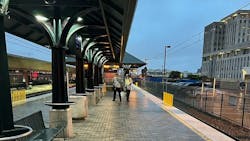Tropical Storm Hilary impacts transit operations from Southern California to Nevada
Tropical Storm Hilary made landfall in Mexico Aug. 20. before moving into southern California and bringing high winds and heavy rains into the state. Transit systems from California through Nevada experienced service disruptions due to the storm’s impact.
The National Hurricane Center issued a bulletin Sunday evening, stating the storm’s sustained winds were at 45 mph with higher gusts. The storm is expected to weaken as it moves further inland, with the National Hurricane Center anticipating it will become a post-tropical cyclone by early Monday. However, the storm’s remnant moisture will be responsible for heavy rainfall and high wind gusts through Monday. The National Center for Environmental Prediction estimates areas of southern California received between 3.5 inches and 8.5 inches of rain between the morning of Aug. 18 through the evening of Aug. 20.
The storm’s impact on transit services has varied. SunLine Transit Agency in Thousand Palms and Long Beach Transit both suspended bus service. Long Beach Transit cited flooding and expects to resume service Monday, Aug. 21.
North County Transit District (NCTD) reported Sunday afternoon all modes were experiencing reduced service. NCTD canceled Coaster trains that were to operate after 2 p.m. Sunday afternoon. The closing of the NCTD’s track in San Diego County impacted some Metrolink service with four Metrolink trains that were to depart Oceanside Sunday afternoon departing from Laguna Niguel/Mission Viejo Station. Other than the train schedule adjustment, Metrolink reports no infrastructure had sustained any issues related to the storm as of Sunday afternoon. As of the morning of Aug. 21, NCTD was in the process of restoring service to Sprinter, Breeze, Lift and Coaster.
San Diego Metropolitan Transit System suspended one bus route and detoured seven additional bus routes to avoid areas that experienced heavy rains.
Los Angeles County Metropolitan Transportation Authority (L.A. Metro) crews worked in the hours before the storm’s arrival to ensure drains at rail stations and along track were cleared to allow for proper drainage. Additionally, the authority shut off escalators at five stations due to threats of flooding. L.A. Metro also removed rail gate crossing arms from service at 12 locations on its A Line, three locations on its K Line and one location on its E Line due to high winds. The authority said lights continued to flash and trains stopped at the crossings, where the arms were removed as an extra precaution. L.A. Metro posted an update to its X account (formerly Twitter) stating all crossings had returned to service as of 6:45 a.m. PDT on Aug. 21.
In Nevada, the Regional Transportation Commission of Southern Nevada issued an alert ahead of Monday’s service, cautioning riders to expect delays due to the storm and advising them to avoid travel if possible.
About the Author

Mischa Wanek-Libman
Group Editorial Director
Mischa Wanek-Libman is director of communications with Transdev North America. She has more than 20 years of experience working in the transportation industry covering construction projects, engineering challenges, transit and rail operations and best practices.
Wanek-Libman has held top editorial positions at freight rail and public transportation business-to-business publications including as editor-in-chief and editorial director of Mass Transit from 2018-2024. She has been recognized for editorial excellence through her individual work, as well as for collaborative content.
She is an active member of the American Public Transportation Association's Marketing and Communications Committee and served 14 years as a Board Observer on the National Railroad Construction and Maintenance Association (NRC) Board of Directors.
She is a graduate of Drake University in Des Moines, Iowa, where she earned a Bachelor of Arts degree in Journalism and Mass Communication.
